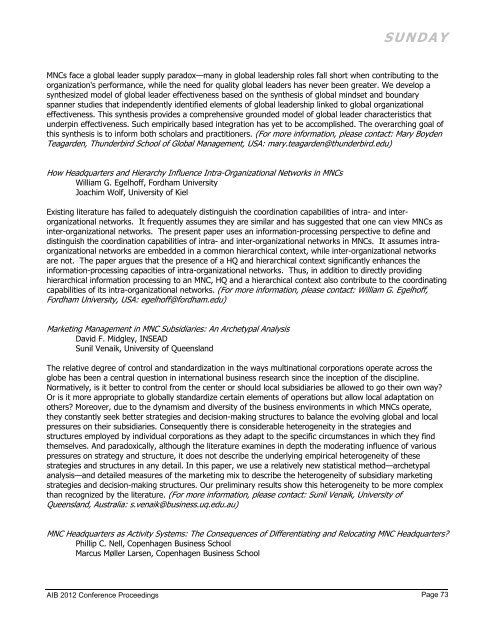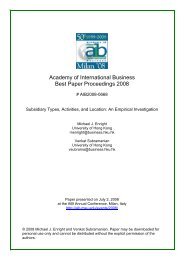AIB 2012 Conference Proceedings - Academy of International ...
AIB 2012 Conference Proceedings - Academy of International ...
AIB 2012 Conference Proceedings - Academy of International ...
Create successful ePaper yourself
Turn your PDF publications into a flip-book with our unique Google optimized e-Paper software.
SUNDAY<br />
MNCs face a global leader supply paradox—many in global leadership roles fall short when contributing to the<br />
organization's performance, while the need for quality global leaders has never been greater. We develop a<br />
synthesized model <strong>of</strong> global leader effectiveness based on the synthesis <strong>of</strong> global mindset and boundary<br />
spanner studies that independently identified elements <strong>of</strong> global leadership linked to global organizational<br />
effectiveness. This synthesis provides a comprehensive grounded model <strong>of</strong> global leader characteristics that<br />
underpin effectiveness. Such empirically based integration has yet to be accomplished. The overarching goal <strong>of</strong><br />
this synthesis is to inform both scholars and practitioners. (For more information, please contact: Mary Boyden<br />
Teagarden, Thunderbird School <strong>of</strong> Global Management, USA: mary.teagarden@thunderbird.edu)<br />
How Headquarters and Hierarchy Influence Intra-Organizational Networks in MNCs<br />
William G. Egelh<strong>of</strong>f, Fordham University<br />
Joachim Wolf, University <strong>of</strong> Kiel<br />
Existing literature has failed to adequately distinguish the coordination capabilities <strong>of</strong> intra- and interorganizational<br />
networks. It frequently assumes they are similar and has suggested that one can view MNCs as<br />
inter-organizational networks. The present paper uses an information-processing perspective to define and<br />
distinguish the coordination capabilities <strong>of</strong> intra- and inter-organizational networks in MNCs. It assumes intraorganizational<br />
networks are embedded in a common hierarchical context, while inter-organizational networks<br />
are not. The paper argues that the presence <strong>of</strong> a HQ and hierarchical context significantly enhances the<br />
information-processing capacities <strong>of</strong> intra-organizational networks. Thus, in addition to directly providing<br />
hierarchical information processing to an MNC, HQ and a hierarchical context also contribute to the coordinating<br />
capabilities <strong>of</strong> its intra-organizational networks. (For more information, please contact: William G. Egelh<strong>of</strong>f,<br />
Fordham University, USA: egelh<strong>of</strong>f@fordham.edu)<br />
Marketing Management in MNC Subsidiaries: An Archetypal Analysis<br />
David F. Midgley, INSEAD<br />
Sunil Venaik, University <strong>of</strong> Queensland<br />
The relative degree <strong>of</strong> control and standardization in the ways multinational corporations operate across the<br />
globe has been a central question in international business research since the inception <strong>of</strong> the discipline.<br />
Normatively, is it better to control from the center or should local subsidiaries be allowed to go their own way<br />
Or is it more appropriate to globally standardize certain elements <strong>of</strong> operations but allow local adaptation on<br />
others Moreover, due to the dynamism and diversity <strong>of</strong> the business environments in which MNCs operate,<br />
they constantly seek better strategies and decision-making structures to balance the evolving global and local<br />
pressures on their subsidiaries. Consequently there is considerable heterogeneity in the strategies and<br />
structures employed by individual corporations as they adapt to the specific circumstances in which they find<br />
themselves. And paradoxically, although the literature examines in depth the moderating influence <strong>of</strong> various<br />
pressures on strategy and structure, it does not describe the underlying empirical heterogeneity <strong>of</strong> these<br />
strategies and structures in any detail. In this paper, we use a relatively new statistical method—archetypal<br />
analysis—and detailed measures <strong>of</strong> the marketing mix to describe the heterogeneity <strong>of</strong> subsidiary marketing<br />
strategies and decision-making structures. Our preliminary results show this heterogeneity to be more complex<br />
than recognized by the literature. (For more information, please contact: Sunil Venaik, University <strong>of</strong><br />
Queensland, Australia: s.venaik@business.uq.edu.au)<br />
MNC Headquarters as Activity Systems: The Consequences <strong>of</strong> Differentiating and Relocating MNC Headquarters<br />
Phillip C. Nell, Copenhagen Business School<br />
Marcus Møller Larsen, Copenhagen Business School<br />
<strong>AIB</strong> <strong>2012</strong> <strong>Conference</strong> <strong>Proceedings</strong><br />
Page 73

















